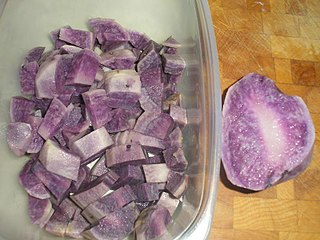 W
WThis is a list of potato varieties or cultivars. Potato cultivars can have a range of colors due to the accumulation of anthocyanins in the tubers. These potatoes also have coloured skin, but many varieties with pink or red skin have white or yellow flesh, as do the vast majority of cultivated potatoes. The yellow colour, more or less marked, is due to the presence of carotenoids. Varieties with coloured flesh are common among native Andean potatoes, but relatively rare among modern varieties. They are rarely cultivated because their yield is usually lower than that of improved varieties and are sought after by some amateurs as a curiosity.
 W
WThe 'Adirondack Blue' is a potato variety with blue flesh and skin with a slight purple tint, released by Cornell University potato breeders Robert Plaisted, Ken Paddock, and Walter De Jong in 2003.
 W
WAdirondack Red is a potato variety with red flesh and skin, bred by Cornell University potato breeders Robert Plaisted, Ken Paddock and Walter De Jong, and released in 2004.
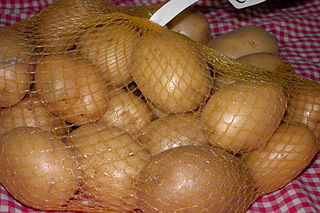 W
WThe Agata is a Dutch potato variety. It is a very early maturing, yellow-skinned, yellow-fleshed variety with an attractive bright skin. Agata produces high yields of uniform shaped tubers and is known for its high pack-out. It was bred by Svalöf Weibull A.B., from the cross BM 52-72 X Sirco in Emmeloord in 1976.
 W
WThe almond potato, also called Mandel potato or Swedish peanut fingerling, is a potato known since the 19th century. Almond potatoes are yellow or white; in rare cases a variety called blue almond can be found which has yellow-white flesh with blue skin. Its shape is oval and somewhat resembles an almond, hence the name. Blue almond is an old variety which was grown in the northern regions of Sweden before the yellow-peeled almond potato was introduced.
 W
WAmflora is a genetically modified potato cultivar developed by BASF Plant Science. "Amflora" potato plants produce pure amylopectin starch that is processed to waxy potato starch. It was approved for industrial applications in the European Union on 2 March 2010 by the European Commission. In January 2012, the potato was withdrawn from the market in the EU.
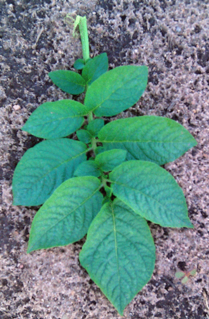 W
WThe Atlantic potato is a mid-season chipping potato variety. It was developed and released by USDA Agricultural Research Service scientists at Beltsville, Maryland, in 1978. The variety is not under plant variety protection. It is a progeny of a cross between 'Wauseon' and 'Lenape'. It is widely grown for chipping directly off the field or with short-term storage. Marketable yields are fairly high.
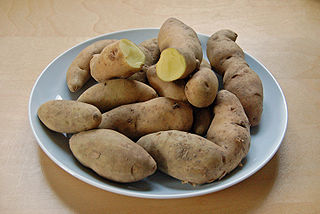 W
WThe Bamberg potato is an old potato variety from Franconia. It takes its name from the town of Bamberg.
 W
WBintje is a middle-early ripening potato variety bred in the Netherlands by the Frisian schoolmaster K.L. de Vries in 1904 from and marketed for the first time in 1910. The name of the potato, a diminutive of Benedict, was borrowed from one of his former students.
 W
WThe potato is a root vegetable native to the Americas, a starchy tuber of the plant Solanum tuberosum, and the plant itself is a perennial in the nightshade family, Solanaceae.
 W
WThe Désirée potato is a red-skinned main-crop potato originally bred in the Netherlands in 1962. It has yellow flesh with a distinctive flavour and is a favourite with allotment-holders because of its resistance to drought, and is fairly resistant to disease. It is a versatile, fairly waxy variety which is firm and holds its shape, and is useful for all methods of cooking, from roasting to mashing and salads.
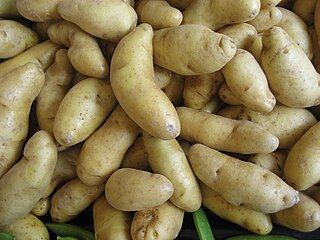 W
WA fingerling potato is a small, stubby, finger-shaped type of potato which may be any heritage potato cultivars. Fingerlings are varieties that naturally grow small and narrow. They are fully mature when harvested and are not to be confused with new potatoes. Popular fingerling potatoes include the yellow-skinned Russian Banana, the pink-skinned, yellow fleshed French Fingerling, the Purple Peruvian, and the Swedish Peanut Fingerling. Due to their size and greater expense compared to other potatoes, fingerlings are commonly either halved and roasted as a side dish or used in salads.
 W
WThe Jersey Royal is the marketing name of a type of potato grown in Jersey which has a Protected Designation of Origin. The potatoes are of the variety known as International Kidney and are typically grown as a new potato.
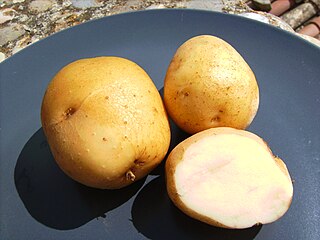 W
WKennebec is a medium- to late-maturing white potato. It was bred by the USDA and selected by Presque Isle Station, Maine, in 1941. Kennebec is not under plant variety protection. This fast-growing variety has high yields. It maintains good quality in storage and is grown for both fresh market use and chipping.
 W
WKing Edward is a potato variety grown in the UK since 1902, making it one of the oldest varieties still grown commercially.
 W
WLaura is a mid-season-ripening, firm-fleshed, edible potato. The Laura potato is red-skinned with a rich potato-yellow flesh color and an oval shape. It was first recognised in 1998 in Austria. The depth of the eyes is between flat and very flat.
 W
WMāori potatoes or taewa are varieties of potato cultivated by Māori people, especially those grown before New Zealand was colonised by the British.
 W
WMelody is a cultivar of potato.
 W
WThe Ozette, also known locally as Makah Ozette or Anna Cheeka's Ozette is the oldest variety of potato grown in the Pacific Northwest region. This potato, of the petite heirloom fingerling type, was grown for over two centuries by the Makah tribe native to Washington and was "rediscovered" in the late 1980s.
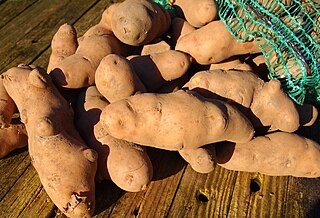 W
WThe Pink Fir Apple potato is a maincrop potato variety with a long knobbly shape, pink skin, and creamy waxy flesh. It was first imported to the UK from France in 1850, and in 1996 was crossed with the Désirée variety to form the Anya potato for Sainsbury's supermarkets. Its shape makes it difficult to peel.
 W
WThe Ratte potato is a small potato with a unique nutty flavor and smooth, buttery texture. The nutty flavour is said to have come from the types of soils the variety is grown in by the French farmers. This potato has an ovate shape, often with a slight curve and golden speckled skin. The flesh of this potato is a golden yellow and its texture maintains even when cooking. The variety originated in Denmark or France, in the late 19th century and is a favorite of French chefs, including Joël Robuchon who used them to make potato puree. Other chefs have recommended roughly mashing them or using them in salads or casseroles. The New York Times reported that its taste "hints richly of hazelnuts and chestnuts". This variety is known for its excellent texture and flavour, it is normally harvested by hand and low yielding. Because of the low yield and hand harvest this variety fetches a high price and it is known as a boutique potato.
 W
WRusset Burbank is a potato cultivar with dark brown skin and few eyes that is the most widely grown potato in North America. A russet type, its flesh is white, dry, and mealy, and it is good for baking, mashing, and french fries (chips). It is a common and popular potato.
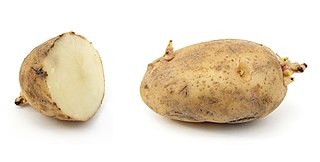 W
WA russet potato is a type of potato that is large, with dark brown skin and few eyes. The flesh is white, dry, and mealy, and it is suitable for baking, mashing, and french fries. Russet potatoes are also known as Idaho potatoes in the United States.
 W
WShetland Black is a dark purple heritage variety of potato. It comes from the Shetland Islands, and was developed in the Victorian era. The plant grows to a height of about 2.5 feet (0.76 m), and is shallow-rooted and thus suitable for container growing. The potato is suitable for roasting, baking or steaming. The potato is fairly small compared with modern cultivars, and when sliced has a purple ring near the edge. Once cooked it has a fluffy floury texture.
 W
WVitelotte,, is a gourmet French variety of blue-violet potato. It has been cultivated in France at least since the early 19th century.
 W
WYukon Gold is a large cultivar of potato most distinctly characterized by its thin, smooth, eye-free skin and yellow-tinged flesh. This potato was developed in the 1960s by Garnet ("Gary") Johnston in Guelph, Ontario, Canada, with the help of Geoff Rowberry at the University of Guelph. The official cross was made in 1966 and 'Yukon Gold' was finally released into the market in 1980.